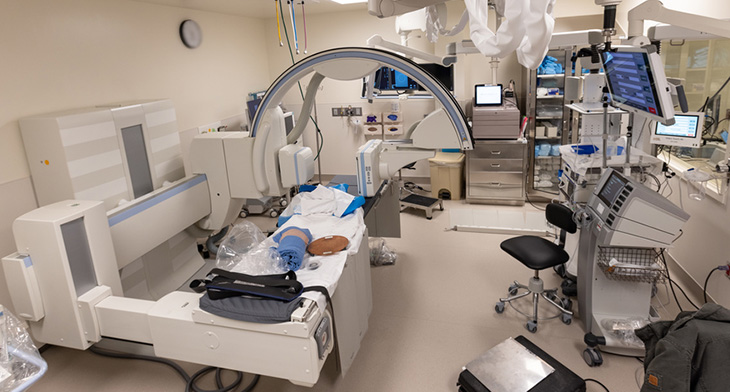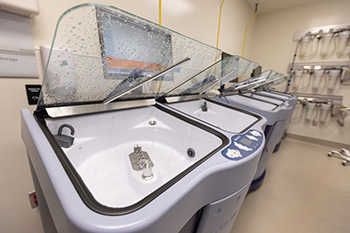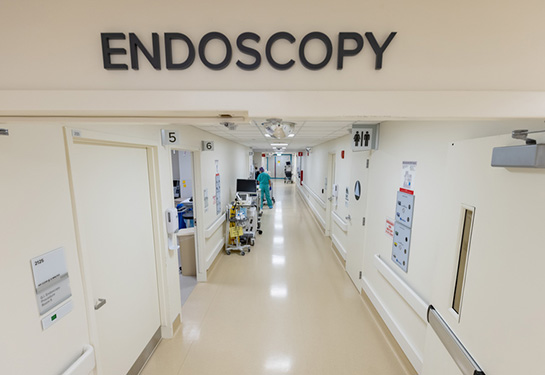UC Davis Health opens new endoscopy suite
State-of-the-art suite is characterized by advanced technology and integrated care
A new outpatient endoscopy suite is now open at UC Davis Health as part of ongoing efforts to improve patient care and enhance technologies that result in superior outcomes and experiences.
The University Tower Endoscopy Suite opened in July 2022 on the second floor of UC Davis Medical Center. Staffed by a team of nurses and patient care technicians, the suite caters to patients from gastroenterology, interventional pulmonology and colorectal surgery.
“This new suite is a step forward in the care that we deliver at UC Davis Health with the more spacious area to accommodate the growing volume of endoscopy procedures,” said John Ortiz, nurse manager of the University Tower Endoscopy Suite. “The advanced equipment and thoughtful layout offer our physicians, nurses, and technicians the ideal setting to provide the highest quality and most compassionate patient-centered care.”
Endoscopy refers to minimally invasive procedures that utilize various types of flexible instruments known as “scopes,” which may incorporate surgical implements as well as tiny cameras to assist the physician’s skill.
The new suite gives physicians a dedicated endoscopy facility within the Division of Perioperative Services. It has eight procedure rooms. This includes rooms with HVAC air isolation, rooms with technology to provide complex interventional procedures, a recovery bay, and a state-of-the-art flexible scope processing room.
The team provides advanced care for gastroenterology and interventional pulmonology needs, including both complex and routine procedures, including:
- Colonoscopies
- Upper GI endoscopies to diagnose and treat problems in the esophagus, stomach, and small intestine
- Procedures to diagnose diseases of the gallbladders, biliary system, pancreas, and liver
- Minimally invasive pulmonary bronchoscopy procedures to diagnose and treat disorders of the lungs and airways

Technologies and new procedures
The endoscopy suite features state-of-the-art technology to assist with endoscopy procedures. This includes interventional gastroenterology procedures visually aided with advanced integrated fluoroscopy suites, 3-D mobile C-arm system, and minimally invasive biopsy of the lungs utilizing the Ion Endoluminal Robotic-Assisted Platform by Intuitive.
3-Dimensional Mobile C-arm systems are used for diagnostic imaging and minimally invasive procedures. A 3-D mobile C-arm gives physicians enhanced visualization of anatomical structures, enable less-invasive approaches and resulting in shorter hospital stays.
The Ion Endoluminal Platform by Intuitive is a high-tech system that creates a 3D map of a patient’s lungs using a CT scan. One of the procedures that utilizes the Ion Endoluminal Platform is the robotic-assisted bronchoscopy procedure. Interventional pulmonology recently celebrated the completion of its 100th robotic-assisted bronchoscopy procedure in the endoscopy suite.
“The advanced technology we have allows us to care for some of the most sick and complex patients in our community,” explained Ortiz. “Many of our patients require more advanced procedures than other health providers in the community can usually support.”
Cleaning of endoscopy scopes
The new suite is equipped with the Sacramento region’s most advanced automated cleaning and storage system of flexible endoscopes. This scope processing room leverages technology to help reduce human error and eliminate cross-contamination, while making patient-ready endoscopes safely available for every patient.

Within the endoscope processing room highly trained and certified technologists manually clean and inspect scopes for holes and damage. Next, the scopes are placed in an advanced automated cleaning washer to sterilize them. Last, the scopes are placed in automated drying storage cabinets which monitor the conditions to ensure they remain safe for patient use.
“Our scope processing system is at peak industry standards to ensure patients have highly disinfected and safe scopes for their procedures,” added Ortiz. “It is just another way we are able to secure the safety of and improve the experience of our patients during their procedures.”




